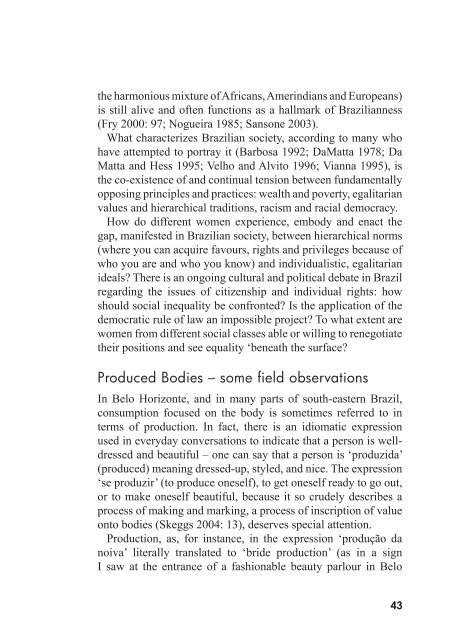Thinking with Bevereley Skeggs - Stockholms universitet
Thinking with Bevereley Skeggs - Stockholms universitet
Thinking with Bevereley Skeggs - Stockholms universitet
- No tags were found...
Create successful ePaper yourself
Turn your PDF publications into a flip-book with our unique Google optimized e-Paper software.
the harmonious mixture of Africans, Amerindians and Europeans)is still alive and often functions as a hallmark of Brazilianness(Fry 2000: 97; Nogueira 1985; Sansone 2003).What characterizes Brazilian society, according to many whohave attempted to portray it (Barbosa 1992; DaMatta 1978; DaMatta and Hess 1995; Velho and Alvito 1996; Vianna 1995), isthe co-existence of and continual tension between fundamentallyopposing principles and practices: wealth and poverty, egalitarianvalues and hierarchical traditions, racism and racial democracy.How do different women experience, embody and enact thegap, manifested in Brazilian society, between hierarchical norms(where you can acquire favours, rights and privileges because ofwho you are and who you know) and individualistic, egalitarianideals? There is an ongoing cultural and political debate in Brazilregarding the issues of citizenship and individual rights: howshould social inequality be confronted? Is the application of thedemocratic rule of law an impossible project? To what extent arewomen from different social classes able or willing to renegotiatetheir positions and see equality ‘beneath the surface?Produced Bodies – some field observationsIn Belo Horizonte, and in many parts of south-eastern Brazil,consumption focused on the body is sometimes referred to interms of production. In fact, there is an idiomatic expressionused in everyday conversations to indicate that a person is welldressedand beautiful – one can say that a person is ‘produzida’(produced) meaning dressed-up, styled, and nice. The expression‘se produzir’ (to produce oneself), to get oneself ready to go out,or to make oneself beautiful, because it so crudely describes aprocess of making and marking, a process of inscription of valueonto bodies (<strong>Skeggs</strong> 2004: 13), deserves special attention.Production, as, for instance, in the expression ‘produção danoiva’ literally translated to ‘bride production’ (as in a signI saw at the entrance of a fashionable beauty parlour in Belo43
















